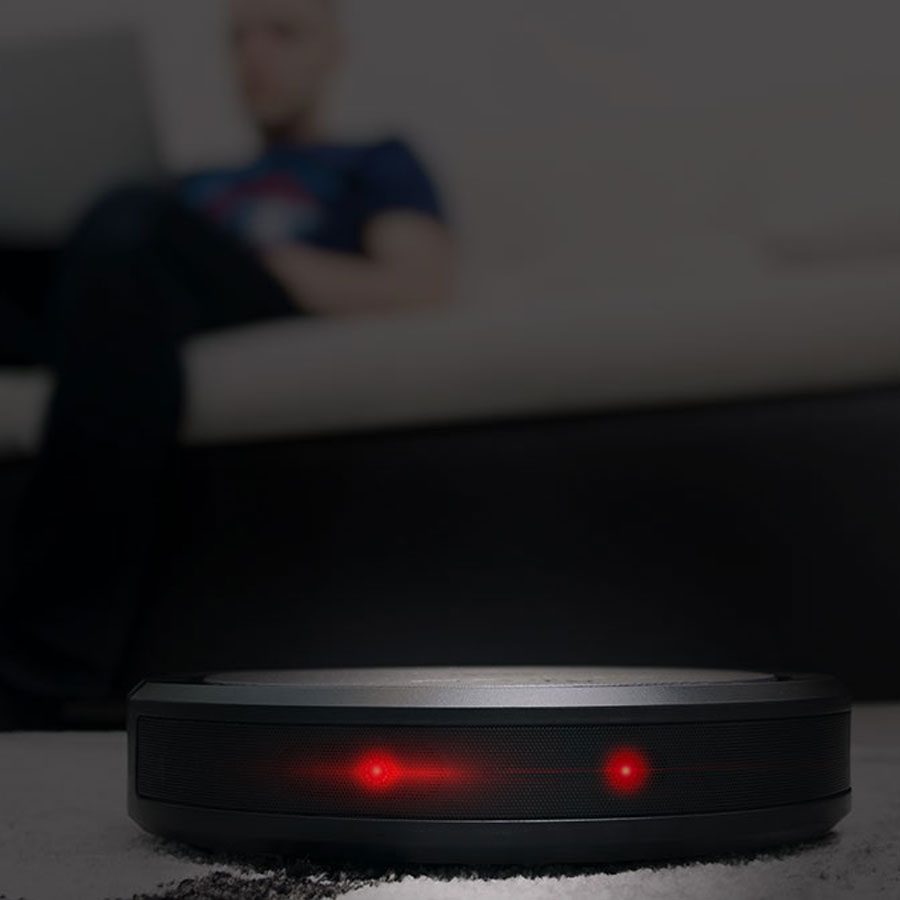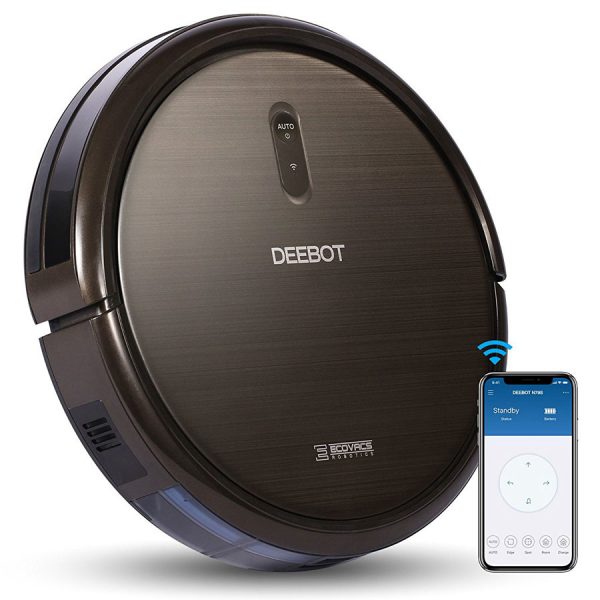Finding out whether a robot vacuum can work in the dark is crucial for picking the correct model for your needs.
The vac’s ability to clean in the dark is vital not only if you want it to work at nighttime.
Some areas of your home might be darker than others or have dark flooring, preventing the robot vacuum from doing its job. Unfortunately, there is no robot vacuum that can work in pitch darkness (yet).
The good news is that many robot vacs suffice with dim light, and some even have built-in LEDs for better navigation. Still, you should follow certain precautions to make the job easier for your little helper.
Note that the best robot vacuum for nighttime isn’t necessarily the most expensive. There are plenty of affordable robot vacs that clean in the dark.
How Robot Vacuums Navigate?
To understand whether robot vacuums can work at night, you should first learn about how robot vacuums work. Specifically, how they navigate and avoid bumping into walls or falling off the stairs.
A robot vacuum can navigate using sensors or mapping technology. The former is an older technology used in the first robot vacuums, but it’s still effective.
A regular camera wouldn’t be able to show a robot vacuum all the hazards and obstacles on its way or measure how far it has traveled. Instead, robot vacs use obstacle sensors that measure the distance to objects and identify where to turn.
The cliff sensor is necessary to prevent the vacuum from falling. The purpose of wall and wheel sensors is apparent from the names.
Sensor navigation has its cons. For example, robots using this technology move in haphazard paths, taking more time to cover the room. However, the inability to work in the dark isn’t one of them.
Most sensors, like lidar, laser, optical, and radar, don’t need a light source. Some robot vacuums even have special sensors that help detect obstacles in low-light conditions.
Higher-end robot vacuums typically rely on cameras and self-navigation systems for floor mapping. Such robots use onboard digital cameras to take pictures of the floor, doorways, walls, and other landmarks.
Then, they create a house map and use it to make more efficient cleaning paths. But while smart mapping is a more advanced technology, it has a significant drawback. Such robot vacuums struggle in low-light conditions.
Which Robot Vacuums Need Light?
One might think that the more a robot vacuum costs, the better it handles low-light conditions, but it isn’t true.
Modern robot vacuums equipped with digital cameras and mapping technology tend to perform worse in the dark than robots with good old sensors.
For example, iRobot Roomba 900 Series vacs use cameras to navigate and therefore need a light source. This robot vacuum won’t work in a pitch-dark room, but it can navigate in dim light.
Roborock S5 also uses frontal cameras and a smart navigation system to map the floor, so don’t expect it to clean your house while you’re asleep.
Other robot vacs that need light include Dyson 360 Eye and Ecovac Deepbot Ozmo T8. But does any robot vacuum with a camera navigation system requires a light source? Not necessarily.
Many high-end robot vacuums with smart mapping technology have infrared sensors in addition to cameras, helping them “see” in the dark.
Which Robot Vacuums Can Work in the Dark?
As a rule of thumb, all robot vacuums with sensor navigation can work in the dark. Examples include Roomba s9+ and Roborock S5 MAX. However, you don’t have to settle on an older model and give up advanced features for night cleaning.
If you want a robot that would clean the house in any light condition, look for one with a bright LED light to illuminate its path. This way, you get the best of both worlds – smart mapping and night vacuuming.
For instance, Dyson 360 Heurist has a 360-degree camera and eight LED lights that help it see obstacles in low light. Plus, it has optic sensors that survey the room every so often.
Problems With Dark Surfaces
Not many guides on the best robot vacuums mention how poorly most of them perform on dark surfaces. The reason robot vacuums don’t work on dark floors is that they mistake them for a cliff.
Some cliff sensors detect any dark surface as an edge, activating the stop mechanism to prevent the vacuum from falling. Unfortunately, if your robot vacuum doesn’t differentiate between a cliff and dark flooring, there is no fix to the problem.
The good news is that many modern robot vacuums work on dark surfaces, including Roomba s9+ and the cheaper Roomba i3. These robot vacuums are equipped with dual-beam sensors that help them navigate seamlessly.
However, problems can arise even with robot vacs that are supposed to perform impeccably on any surface. The reason for this issue is typically dirt or debris on the cliff sensor. To resolve the problem, simply wipe the sensor with a soft cloth.
On the same note, you can use this trait of robot vacs to your advantage. If you want to prevent your robot vacuum from cleaning certain areas, mark them with black tape.
When your robot vac detects the tape, it will reverse and go clean somewhere else.
How to Determine Whether Your Robot Works in the Dark
If you wonder whether your robot vacuum works in the dark, test it. Switch off all the lights and close the curtains. Ensure no light beam comes through. Then, turn on the robot vacuum.
Some vacs might not even move, whereas others will start driving around the room but bump into every obstacle. For example, Roomba robot vacs usually give a verbal warning that the lightning isn’t good enough.
Some robot vacs will get stuck on something invisible. If your vacuum has mapping technology, you might notice it not navigating properly despite doing so in the daytime.
Depending on your vac’s model, you might notice other misbehavior like driving in circles or moving back and forth.
Another way to check whether your robot vac works in low light conditions is to read the technical characteristics on the manufacturer’s website. If your robot vac features infrared sensors or LED lights, it must work in the dark without any issues.
Some people don’t need to vacuum at night but notice their robot doesn’t clean the entire house. Usually, this problem occurs because some areas of the house are lit worse than others.
For instance, your hall or bathroom might not have enough light because there are no windows. In that case, your robot vacuum will avoid these areas, and you need to come up with a solution to fix the issue.
Interestingly, some robot vacuums might be equally confused by too much light or a rapid change in lighting conditions. Say, the sun suddenly comes out, or you turn on the lights in the room.
How to Make Your Robot Better at Cleaning at Night
Even if you have an advanced high-end robot vacuum that cleans in any light condition, you will benefit from some tips on making a robot vacuum better at cleaning in the dark.
Even the best robot vacuums that work in the dark require some degree of light. Vacs using a combination of cameras and LEDs already have a light source on board, but vacs using infrared sensors don’t.
To ease the job for your robot vac, leave some lights on – it could be a night light, torch, or an LED candle.
Now, you might wonder – how much light does a robot vacuum need, precisely? Robot vacs with cameras need about 40-90 lumens or 10%-15% of a regular 40-Watt light bulb.
As a rule of thumb, there should be just enough light to find a way in the dark but not to see each color and detail of your surroundings.
Ensure that the cleaning area is free of clutter. Remove your dog’s toys, kid’s crafting tools, shoes, and other smaller objects from the floor. Move furniture closer to the walls to free a larger area.
If some areas of your home have no windows and thus no light, leave the doors open. This way, some light will get through, and it might be enough for your robot vac to clean.
Alternatively, you can add an automatic ambient light that will turn on when it detects movement of the vac. You won’t have to spend much on electricity because the light will only work while the vac is in the area.
Remember to keep your vacuum sensors and cameras clean. Even the best robot vacs will do a poor job of cleaning your home at night when their navigation system is covered with debris.
If you’ve recently bought a new robot vacuum with smart mapping technology, let it do a practice run in a well-lit room. The vac will create a proper map of your house and find navigating in low-light conditions easier.
Sources
- diysmarthomeplanet.com/roomba-in-the-dark/#This_is_why_navigation_systems_play_a_major_role
- www.aeg.co.uk/support/support-articles/vacuum-cleaners/robotic-vacuum-cleaners/does-the-robotic-vacuum-need-light-for-operating/
- lifeonai.com/can-roomba-work-in-dark/
- cleanerstalk.com/do-robot-vacuums-work-on-dark-floors/
- didyouknowhomes.com/can-a-robotic-vacuum-work-in-dark-rooms-and-surfaces/
- themvacuums.com/can-a-robot-vacuum-work-in-the-dark/
- living-smarter.com/can-roombas-and-other-robot-vacuums-clean-in-the-dark/
- www.techhive.com/article/583321/how-a-robot-vacuum-navigates-your-home.html
- sortatechy.com/can-robot-vacuums-clean-in-the-dark/

